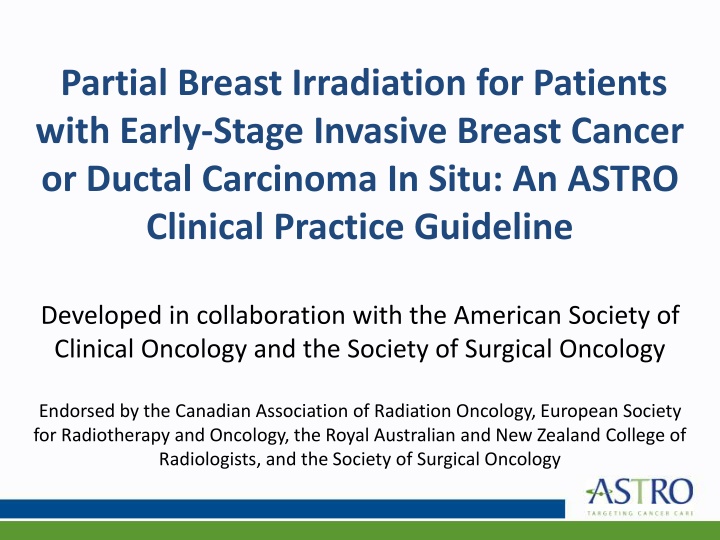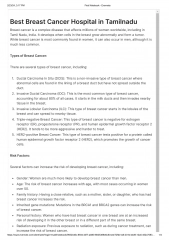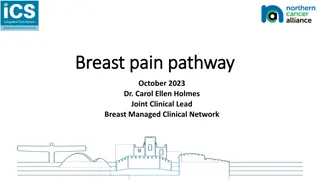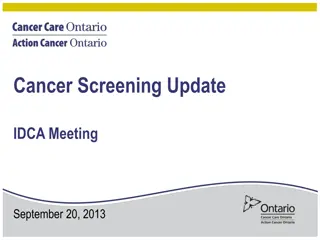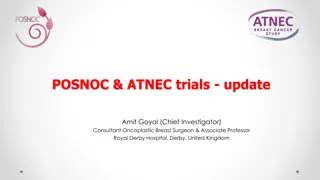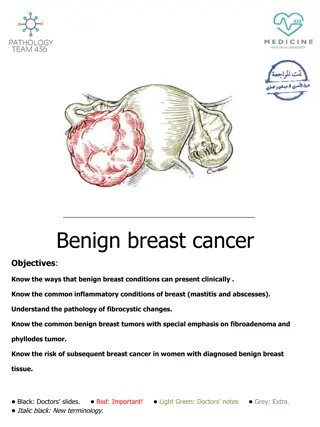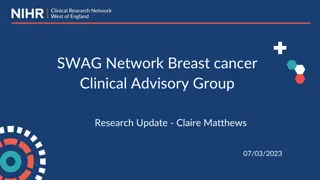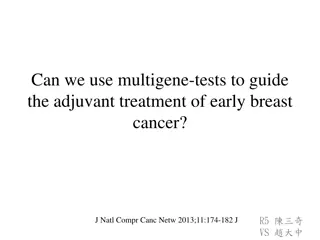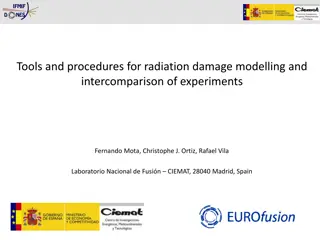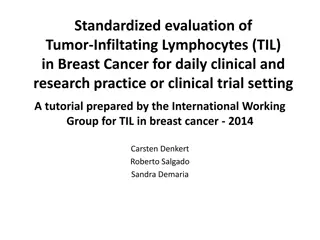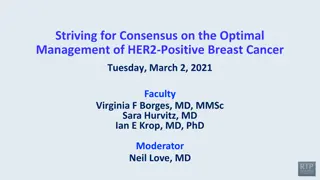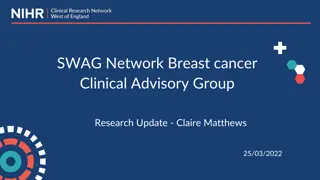Partial Breast Irradiation Guidelines for Early-Stage Breast Cancer
This guideline developed in collaboration with various oncology societies offers recommendations for partial breast irradiation (PBI) in patients with early-stage invasive breast cancer or ductal carcinoma in situ. It covers patient selection criteria, techniques for delivering PBI, dosing, and treatment planning parameters, aiming to optimize outcomes and enhance patient care.
Download Presentation

Please find below an Image/Link to download the presentation.
The content on the website is provided AS IS for your information and personal use only. It may not be sold, licensed, or shared on other websites without obtaining consent from the author.If you encounter any issues during the download, it is possible that the publisher has removed the file from their server.
You are allowed to download the files provided on this website for personal or commercial use, subject to the condition that they are used lawfully. All files are the property of their respective owners.
The content on the website is provided AS IS for your information and personal use only. It may not be sold, licensed, or shared on other websites without obtaining consent from the author.
E N D
Presentation Transcript
Partial Breast Irradiation for Patients with Early-Stage Invasive Breast Cancer or Ductal Carcinoma In Situ: An ASTRO Clinical Practice Guideline Developed in collaboration with the American Society of Clinical Oncology and the Society of Surgical Oncology Endorsed by the Canadian Association of Radiation Oncology, European Society for Radiotherapy and Oncology, the Royal Australian and New Zealand College of Radiologists, and the Society of Surgical Oncology
Citation This slide set is adapted from the Partial Breast Irradiation for Patients With Early-Stage Invasive Breast Cancer or Ductal Carcinoma In Situ Guideline to be published in the March/April 2024 issue of Practical Radiation Oncology (PRO) Web posted link: (https://doi.org/10.1016/j.prro.2023.11.001) The full-text guideline is also available on the ASTRO website: www.astro.org
Guideline Task Force Chairs Janice A. Lyons, MD Simona F. Shaitelman, MD, EdM Members Bethany M. Anderson, MD Douglas W. Arthur, MD Jose G. Bazan, MD Jennifer R. Bellon, MD Charlotte Coles, MRCP, FRCR, PhD Naamit K. Gerber, MD Madeera Kathpal, DO Leonard Kim, MS, AMusD Christine Laronga, MD Icro Meattini, MD Elizabeth M. Nichols, MD Lori J. Pierce, MD Matthew M. Poppe, MD Patricia A. Spears, BS Shaveta Vinayak, MD Timothy Whelan, BM BCh
Task Force Composition Multidisciplinary team of academic and community-based radiation, medical, and surgical oncologists; a medical physicist; and a member of the Guideline Subcommittee Related societies American Society of Clinical Oncology (ASCO)* Society of Surgical Oncology (SSO)* Patient representative *Representatives nominated by specialty societies.
Introduction to Guideline Breast cancer is the leading cause of global cancer incidence and remains a leading cause of cancer mortality worldwide, with an estimated 2.3 million new cases in 2020. We now have 10-year follow-up of several RCTs comparing whole breast irradiation (WBI) and partial breast irradiation (PBI) for patients with early-stage breast cancer. This guideline provides guidance on which patients are candidates for PBI, appropriate techniques for delivering PBI as well as dosing and treatment planning parameters.
Guideline Scope This guideline applies to adult women (age 18 years) with early-stage invasive breast cancer or ductal carcinoma in situ (DCIS) defined as a small lesion 3 cm that has minimal (up to 3 positive) or no lymph node involvement treated with upfront breast conserving surgery, with reported outcomes of interest. It provides guidance on which patients are candidates for PBI, which techniques are preferred with respect to local control and QoL parameters and provides guidance on treatment planning parameters. Outside the scope of this guideline is the role of PBI in the setting of neoadjuvant systemic therapy, more advanced cancers, recurrent or second primary breast cancers, breast augmentation, male breast cancers, the role of PBI followed by WBI, and oncoplastic surgery.
Definitions Conventional Fractionation Fraction size 180-200 cGy Moderate Hypofractionation Fraction size >200 cGy up to 499 cGy Ultrahypofractionation Fraction size 500 cGy
AHRQ Systematic Review Guideline based on Agency for Healthcare Research and Quality (AHRQ) systematic review, commissioned and funded by the Patient-Centered Outcomes Research Institute (PCORI). Search dates: from database inception to June 30, 2022 For comparisons of PBI as an alternative to WBI, only RCTs were included. For comparisons of different PBI techniques, RCTs and comparative observational studies were included. Population: Adult women with early-stage invasive breast cancer or DCIS Intervention: PBI / PBI techniques Comparator: WBI Outcomes: Ipsilateral breast recurrence (IBR), patient-reported and physician-assessed cosmesis, and adverse events 6,727 citations screened; 23 studies reported in 52 articles with a total of 17,510 patients included.
Rating Strength of Recommendation ASTRO s recommendations are based on evaluation of multiple factors including the quality of evidence (QoE) and panel consensus, which, among other considerations, inform the strength of recommendation. QoE is based on the body of evidence available for a particular key question and includes consideration of number of studies, study design, adequacy of sample sizes, consistency of findings across studies, and generalizability of samples, settings, and treatments. Strength of Recommendation Benefits clearly outweigh risks and burden, or risks and burden clearly outweigh benefits. All or almost all informed people would make the recommended choice. Benefits are finely balanced with risks and burden or appreciable uncertainty exists about the magnitude of benefits and risks. Most informed people would choose the recommended course of action, but a substantial number would not. A shared decision-making approach regarding patient values and preferences is particularly important. Overall QoE Grade Recommendation Wording Definition Any (usually high, moderate, or expert opinion) Recommend/ Should Strong Any (usually moderate, low, or expert opinion) Conditionally Recommend Conditional ASTRO Methodology Manual: https://www.astro.org/ASTRO/media/ASTRO/Patient%20Care%20and%20Research/PDFs/ASTRO_GuidelineMethodology.pdf
Rating Quality of Evidence Overall QoE Grade Type/Quality of Study Evidence Interpretation 2 or more well-conducted and highly generalizable RCTs or meta-analyses of such trials. The true effect is very likely to lie close to the estimate of the effect based on the body of evidence. High 1 well-conducted and highly generalizable RCT or a meta- analysis of such trials OR 2 or more RCTs with some weaknesses of procedure or generalizability OR 2 or more strong observational studies with consistent findings. 1 RCT with some weaknesses of procedure or generalizability OR 1 or more RCTs with serious deficiencies of procedure or generalizability or extremely small sample sizes OR 2 or more observational studies with inconsistent findings, small sample sizes, or other problems that potentially confound interpretation of data. Consensus of the panel based on clinical judgement and experience, due to absence of evidence or limitations in evidence. The true effect is likely to be close to the estimate of the effect based on the body of evidence, but it is possible that it is substantially different. Moderate The true effect may be substantially different from the estimate of the effect. There is a risk that future research may significantly alter the estimate of the effect size or the interpretation of the results. Low Strong consensus ( 90%) of the panel guides the recommendation despite insufficient evidence to discern the true magnitude and direction of the net effect. Further research may better inform the topic. Expert Opinion
Consensus Methodology Modified Delphi approach Task force members rated their level of agreement for each recommendation via consensus survey - 5-point Likert scale from strongly disagree to strongly agree - Consensus defined using pre-specified threshold of 75% ( 90% for expert opinion recommendations) agreement Recommendations for which consensus is not achieved are removed or are revised and resurveyed Recommendations achieving consensus but edited with substantive changes after the first round are also resurveyed
KQ 1: What are the appropriate indications for PBI as an alternative to WBI?
KQ 1: Indications for PBI as an alternative to WBI Strength of Recommendation Quality of Evidence KQ1 Recommendations Early-stage invasive breast cancer* 1. PBI is recommended for patients with early-stage invasive breast cancer with all of the following factors: grade 1-2 disease ER-positive histology age 40 years tumor size 2 cm High (for grade, histology, & age 50 years) Strong Moderate (for age 40-49 years & size) 2. PBI is conditionally recommended for patients with early-stage invasive breast cancer with the following factors: grade 3 disease or ER-negative histology or size >2 - 3 cm Implementation remark: PBI may not be appropriate when multiple of these factors are present, given the possibility of a higher recurrence risk. Conditional Low *Early-stage invasive breast cancer is defined as an invasive lesion 3 cm with 0-3 positive lymph nodes.
KQ 1: Indications for PBI as an alternative to WBI Strength of Recommendation Quality of Evidence KQ1 Recommendations (con t) Early-stage invasive breast cancer* 3. PBI is conditionally not recommended for patients with early-stage invasive breast cancer with any of the following factors: HER2-positive tumors not receiving anti-HER2 therapy lymphovascular invasion lobular histology Expert Opinion Conditional Implementation remark: Given low patient numbers accrued to RCTs, higher risk of recurrence with PBI is possible. 4. PBI is not recommended for patients with early-stage invasive breast cancer with any of the following factors: positive lymph nodes positive surgical margins known germline BRCA1/2 mutation age <40 years Expert Opinion Strong
KQ 1: Indications for PBI as an alternative to WBI Strength of Recommendation Quality of Evidence KQ1 Recommendations (con t) DCIS 5. PBI is recommended for patients with DCIS with all of the following factors: low-to-intermediate grade age 40 years size 2cm Implementation remark: While represented in the RCTs, there was a lack of subgroup analyses for pathologic and clinical features of patients treated with DCIS. Expert Opinion Strong
KQ 1: Indications for PBI as an alternative to WBI Strength of Recommendation Quality of Evidence KQ1 Recommendations (con t) DCIS 6. PBI is conditionally recommended for patients with DCIS with the following factors: high grade or size >2 - 3 cm Implementation remark: PBI may not be appropriate when both of these factors are present, given the possibility of a higher recurrence risk. 7. PBI is not recommended for patients with DCIS with any of the following factors: positive surgical margins known germline BRCA1/2 mutation age <40 years Expert Opinion Conditional Expert Opinion Strong
Adjuvant Radiation Therapy Treatment Options for Early-Stage Invasive Breast Cancer or DCIS *The characteristics HER2-positive not receiving HER2-targeted therapy, lobular, and LVI are conditionally not recommended, and the remaining characteristics in this box are not recommended, both due to low patient numbers accrued to RCTs. Higher risk of recurrence is possible with PBI, although this may be an option in limited situations. Re-excision to negative margins is preferred. Abbreviations: DCIS = ductal carcinoma in situ; ER = estrogen receptor; HER2 = Human epidermal growth factor receptor 2; LVI = lymphovascular invasion; PBI = partial breast irradiation; RCTs = randomized controlled trials; WBI = whole breast irradiation.
KQ 2: What are the appropriate PBI techniques with respect to ipsilateral breast recurrence outcomes?
KQ 2: Appropriate PBI techniques with respect to IBR Strength of Recommendation Quality of Evidence KQ2 Recommendations 1. For patients with early-stage invasive breast cancer or DCIS receiving PBI,3-D CRT is recommended. 2. For patients with early-stage invasive breast cancer or DCIS receiving PBI,IMRT is recommended. 3. For patients with early-stage invasive breast cancer or DCIS receiving PBI, multicatheter brachytherapy is recommended. 4. For patients with early-stage invasive breast cancer or DCIS receiving PBI, single-entry catheter brachytherapy is conditionally recommended. Strong High Strong Moderate Strong Moderate Conditional Moderate
KQ 2: Appropriate PBI techniques with respect to IBR Strength of Recommendation Quality of Evidence KQ2 Recommendations (con t) 5. For patients with early-stage invasive breast cancer receiving PBI, electronIORT is not recommended, unless part of a clinical trial or multi-institutional registry. Strong Moderate Implementation remark: For patients considered for electronIORT, the characteristics in KQ1 do not apply. 6. For patients with early-stage invasive breast cancer receiving PBI, kV IORT alone (without WBI) is not recommended, unless part of a clinical trial or multi-institutional registry. Strong Low Implementation remarks: For patients considered for kV IORT, the characteristics in KQ1 do not apply. WBI following kV IORT may be needed for patients with higher risk features.
KQ 3: What are the appropriate dose-fractionation regimes, target volumes, and planning parameters for PBI?
KQ 3: Appropriate dose-fractionation regimes, target volumes, and planning parameters for PBI Strength of Recommendation Quality of Evidence KQ3 Recommendations 1. For patients with early-stage invasive breast cancer or DCIS receiving external beam PBI, 3000 cGy in 5 once daily fractions delivered on nonconsecutive days within 2 weeks is recommended. 2. For patients with early-stage invasive breast cancer or DCIS receiving external beam PBI, 4005 cGy in 15 once daily fractions over 3 weeks is recommended. 3. For patients with early-stage invasive breast cancer or DCIS receiving PBI with HDR brachytherapy, 3010 cGy in 7 fractions, 3200 cGy in 8 fractions, 3400 cGy in 10 fractions delivered twice daily or 5000 cGy with 160- 180 cGy/hour PDR is recommended. Strong Moderate Strong Moderate Strong Moderate Implementation remark: Single-entry PBI trials used 3400 cGy in 10 fractions delivered twice daily.
KQ 4: What are the appropriate PBI techniques with respect to toxicity and cosmesis?
KQ 4: Appropriate PBI techniques with respect to toxicity and cosmesis Strength of Recommendation Quality of Evidence KQ4 Recommendations* 1. For patients with early-stage invasive breast cancer or DCIS eligible for PBI, once daily external beam PBI is recommended, based on fewer late toxicities, and improved cosmesis. 2. For patients with early-stage invasive breast cancer or DCIS eligible for PBI, twice daily external beam PBI to a dose of 3850 cGy in 10 fractions is not recommended, based on poorer cosmetic outcomes. Strong Moderate Strong Moderate *Only techniques of PBI which received a strong strength of recommendation in favor of usage for KQ2 were evaluated.
KQ 4: Appropriate PBI techniques with respect to toxicity and cosmesis Strength of Recommendation Quality of Evidence KQ4 Recommendations (con t)* 3. For patients with early-stage invasive breast cancer or DCIS eligible for PBI, multicatheter brachytherapy is recommended, based on cosmetic outcomes. 4. For patients with early-stage invasive breast cancer eligible for PBI with an intended dose of 4005 cGy in 15 fractions, PBI is recommended over WBI, due to fewer late toxicities and improved cosmesis. Strong Moderate Strong Moderate *Only techniques of PBI which received a strong strength of recommendation in favor of usage for KQ2 were evaluated.
Key Take Away Messages Many patients with early-stage breast cancer are appropriate candidates for PBI. IBR is similar for WBI and PBI in appropriately selected candidates using EBRT and multi- catheter interstitial brachytherapy. Higher IBR is expected for IORT (both IOERT and kvIORT) alone.
Key Take Away Messages Twice daily external beam PBI to a dose of 3850 cGy in 10 fractions is not recommended, based on poorer cosmetic outcomes. Further investigation is needed for underrepresented subgroups in the RCTs (lobular histology, presence of LVI, positive lymph nodes, patients with genetic predisposition to developing breast cancer, and younger patients (<40y) as well as for patients undergoing oncoplastic tissue rearrangement and for those not undergoing surgical evaluation of the axilla.
